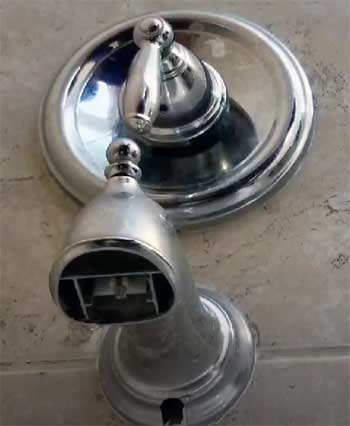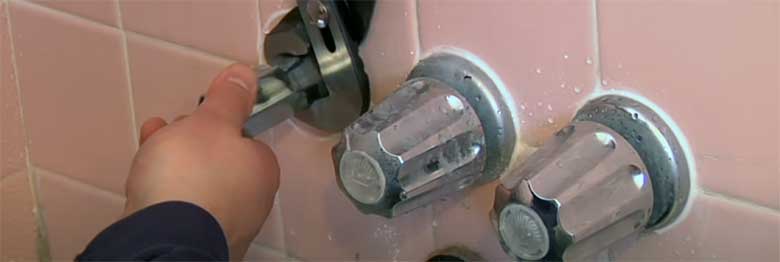When your shower knob turns, but no water comes on, then there could be a variety of reasons for that. In this article, we are going to discuss every detail regarding that, the possible reasons and fixes.
Fixing something doesn’t need to always be hard and when it comes down to shower know it’s not that much difficult. So hold on!
We are going to discuss everything that you need to know!
Possible Reasons of Stripped Shower

- Valves That Balance Pressure
When a toilet flushes or someone switches on the washing machine while you’re bathing, certain tub and shower faucets include a pressure-balancing mechanism that keeps the shower temperature consistent.
The balance spool on these valves might become caught as the faucet ages or if you don’t use it for a long time.
You may be able to obtain cold or hot water when this happens, but the faucet will not mix the cold and hot water. Replace the cartridge if necessary, or remove it and soak it in white vinegar to eliminate mineral deposits.
- Low Water Pressure Or An Old Filter
Simply because it is old, a faucet might break down. It’s possible that the cartridge will get stuck within the valve housing and shear off when you try to spin it, or it might simply become clogged with mineral deposits.
Although you’ll almost certainly need a cartridge puller for the process, you can generally fix the faucet by removing and changing the cartridge.
Insufficient water pressure, which may be caused by old and damaged water pipes, could possibly be the source of your troubles. This is especially true if other faucets or fixtures aren’t working properly.
- Limiter For Temperature

If you can obtain cold water but not hot from your shower faucet, the issue is most likely the temperature restriction.
The limiter is a scald-prevention feature included in most modern faucets, and it’s normally accessed by removing the handle.
You should discover a disk or a couple of disks attached to the valve stem, and you may raise the temperature by rotating one or both of them — you may need to remove them first.
The specific technique varies by model, so if you’re not sure what to do, search the handbook for your faucet on the manufacturer’s website.
- Damage Of The Handle
A set of notches link the handle to the faucet stem, and these can wear out. When this happens, the handle will no longer contact the stem and twisting it will have no impact.
Plastic handles are particularly susceptible to this problem, and while the solution is generally a new handle, you can attempt a method to extend the handle’s life.
Remove the handle, wrap piping tape securely around the stem of the faucet, and reattach the handle. The piping tape may just be enough to restore the handle’s functionality.
- Showerhead Clogged
Mineral deposits can build up inside the microscopic holes of the showerhead over time, obstructing or halting the flow of water.
Allow the showerhead to soak in a basin or bag filled with vinegar overnight to eliminate the mineral build-up.
Next, brush or poke any leftover debris out of the showerhead openings using a tiny instrument.
- A Rusted Mixing Valve
If you have a single-handle shower or tub faucet, it can contain an internal mixing valve that regulates the quantity of hot and cold water flowing to the showerhead.
The temperature and pressure might be thrown off if that valve is jammed or worn out. Because accessing and replacing the mixing valve might be difficult, it should be left to a professional plumber.
- Pipes That Have Corroded Or Are Leaking
From the interior, old pipes, especially those constructed of metal, can corrode or rust.
Mineral deposits in a water supply pipe might obstruct the flow of water to your shower (or other faucets).
The low water pressure might also be an indication of a tiny leak in your plumbing system. It’s critical to find and repair the leak as quickly as possible.
Try These Methods To Fix Your Problematic Shower

- Temporary Fix
You might be able to temporarily fix the problem with just a screwdriver or hex wrench.
Using a flathead screwdriver, take off the cap that covers the set screw on the handle. The cap normally contains the faucet manufacturer’s emblem on one side and a circle with blue on one side and red on the other.
This cap is typically hidden behind the lever on lever-style handles, so you’ll have to seek it.
Attempt to tighten the set screw now. A screwdriver is normally required to tighten screws that hold the handle in place from the top, while a hex wrench is required for side-mount screws.
Your problem may have been addressed if the screw just backed out. Remove it, apply a little amount of thread-locking compound to prevent it from occurring again, and tighten it down.
Wrap the valve stem with three or four wraps of piping tape if tightening the screw doesn’t help.
You want the handle to be snug, but not too tight, or you won’t be able to reattach it. You could discover that if you replace the handle and tighten the set screw, the handle works.
This isn’t a long-term remedy, but it should get you through until you can replace the valve stem or handle.
- Shower Valve Stem Replacement
You’ll have to replace the entire valve if the stem is removed. To remove the valve, turn off the water to the shower and loosen the retaining nut.
If a Moen shower handle is stripped, you may need to remove a holding clip using pliers in order to remove the valve.
If the valve is trapped with scale, which is likely given how old it is, you may need to buy, borrow, or rent a valve extractor, which is a corkscrew-like instrument, to push it out.
Take the valve to a hardware shop, study the manufacturer’s website, or look for a replacement on an internet plumbing parts provider once it’s been removed.
- Replace Or Repair The Handle
Cut the main water valve to the closed position to turn off the water in your home. Turn on a faucet that is lower in elevation than the shower to relieve any remaining water pressure in the pipes.
Locate the set screw that secures the knob to the faucet assembly and remove it. The screw-on some faucets are hidden behind a domed cap on the knob, while the screw-on others are hidden in a tiny hole on the side of the knob.
To remove the knob from the faucet, pull it toward you. If you can’t remove the knob by hand, clamp and handle a puller tool to it, then spin the tool’s post clockwise until the knob comes off.
Look for damage or corrosion on the splines on the inside of the shower knob. Examine the splines on the end of the shower valve stem for any signs of damage or corrosion.
If the valve stem has to be changed, use an adjustable wrench to crank it counterclockwise until it comes out of the pipe.
Reverse the methods used to remove the faucet and reassemble it with the new valve stem or knob. Slowly move the main valve to the open position to restore water to your home.
Final Words
We hope our article has helped you out to find out the reasons why your shower knob turns but no water flow seems to go. Though going through the process may sound a bit difficult but it’s not really like
that.
With the info we have provided hopefully you will be able to fix the problem or in case you can’t, there is always an option for a plumber!
